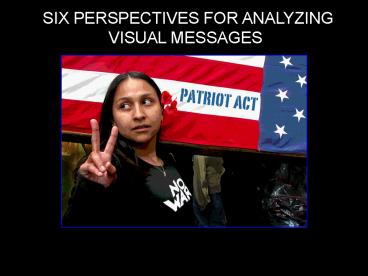SIX PERSPECTIVES FOR ANALYZING VISUAL MESSAGES PowerPoint PPT Presentation
1 / 13
Title: SIX PERSPECTIVES FOR ANALYZING VISUAL MESSAGES
1
SIX PERSPECTIVES FOR ANALYZING VISUAL MESSAGES
2
FIRST LOOK AT ALL MAJOR GRAPHIC AND CONTENT
ELEMENTS
3
1) Make inventory list of all objects in the
picture
4
2) Actively notice composition Note use of
shadows, light
5
3) Study visual cues of color, form, depth,
movement.
6
4) Where was it made? What was its purpose? Is it
news, art, a personal snapshot?
7
- PERSONAL
- Reveals much about the person making the comments
- Opinions have limited use because they are so
personal - Does not reveal much about how a culture would
view the image - Memorable images spark strong personal reactions,
either negative or positive - Denies the chance to perceive the image in a more
meaningful way
8
HISTORICAL ? Knowledge of a mediums history
allows you to understand current trends ?
Creative visual production relies on awareness of
what has come before ? Gives information on roots
of techniques, philosophies of the past
9
TECHNICAL ? Thorough critique requires knowledge
of how producer generated image(s) ? Puts you in
a position to know if the production values were
high or low ? Better understanding of expenses
involved in creating images
10
ETHICAL ? Ethics date back over 2,500 years of
Western moral philosophy ? Similar ethics are
considered in public policies, law, and social
conventions ? Six principal ethical philosophies
categorical imperative, utilitarianism, hedonism,
the golden mean, the golden rule and the veil of
ignorance
11
CULTURAL ? Involves identifying the symbols used
in the image (closely related to semiotics) ?
Determining their meaning for the society as a
whole (current cultural values) ? Analyze the
form of the narrative structure ? Includes use of
words that accompany images
12
CRITICAL ? Attempt to transcend a particular
image and draw general conclusions about medium,
the culture from which it was produced, and the
viewer (response) ? Redefines a persons initial
personal perspective in terms of conclusions
about human nature ? Allows viewer to use
information learned from the medium, its
practitioner, and the image to make general
comments about the society that accepts or
rejects the image(s)
13
(No Transcript)

